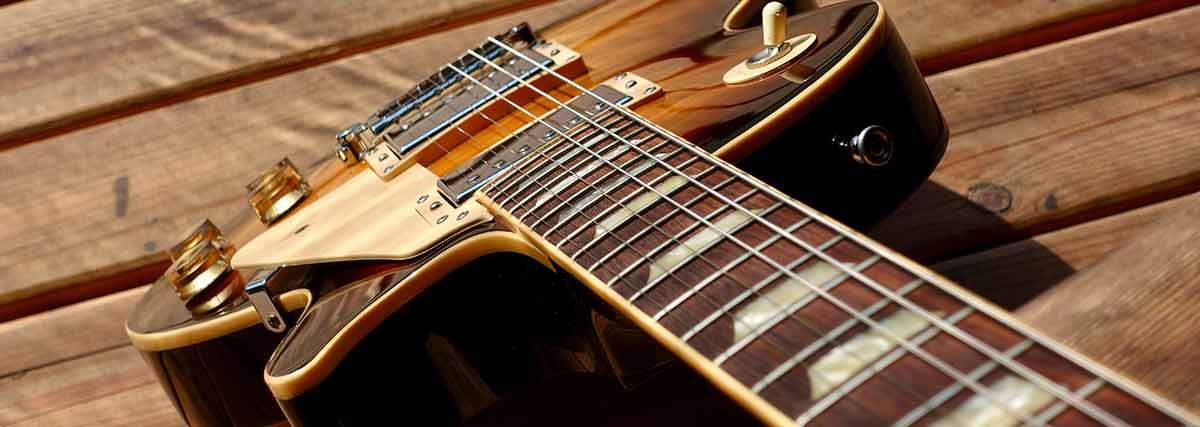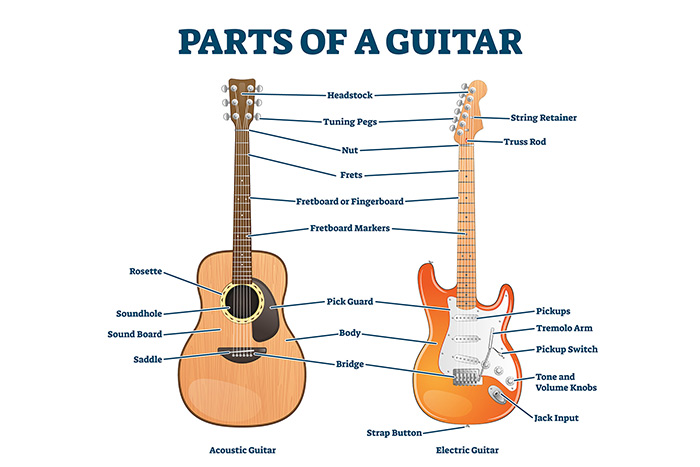Many guitarists will reach a point when they want to understand more of what they are playing, rather than relying on shapes or thinking about fret numbers! Memorising the notes on the fretboard is a great way to do this, and can be achieved a few different ways.
Learning the guitar is quite a unique experience when it comes to learning the theory behind what you are playing, or even what notes you are playing. This is due to the guitars layout across the neck, being much less visually helpful when it comes to memorising the notes of the fretboard. This is much different to a piano where each note will go up by one semitone at a time and each black key representing a sharp or flat note, with each octave of the piano being laid out the exact same way. Due to the fourth and third interval tuning of the guitar strings, each position on the neck will have a different sequence of notes and intervals which will be visually very different also. This is why guitarists will often rely on ‘shapes’ across the neck to memorise their scales and chords rather than thinking about the actual notes that they are playing. So how do we break out of this way of thinking?
Learning Classical Guitar Notation
One thing that I have always been grateful for in my study of the guitar was my early years of playing and taking lessons, where I was learning classical guitar from sheet music. I believe that this is a great way to learn the guitar as this sets up the player with not only an accurate technique but also strong fundamentals such as thinking about the notes on the fretboard and also reading music, both of which are skills that can be transferred into the wide world of music theory. Typically, learning classical guitar notation will start you off in the open position of the guitar neck on all six strings, learning the notes of the open strings up to the third fret or so.
This is great because you think about what note names these frets represent, and where these notes fall onto the musical stave. Once you have a bit of experience in this position, you will gradually work your way up into different positions across the neck, expanding from open position to fifth position, then continuing up from there. Once you have a strong understanding of the notes in open position, it can be much easier to transfer these notes into other positions on the neck. Even if being a classical guitarist isn’t your long term goal, learning the basics out of a book can be a great way to build on this knowledge which will improve all aspects of your playing. Some good books for beginners are Enjoy Playing Guitar (Book 1) by Debbie Cracknell and Classical Guitar Technique, Vol 1 by Aaron Shearer.
Exercise
If classical guitar really isn’t your bag then there are other ways and exercises to improve your knowledge of the fretboard. A popular exercise that is used amongst more contemporary styled players is choosing a note to then play that note on each string across the neck. For example:
- Let’s pick the note G!
- Starting on the low E string, play a G on this string (3rd fret)
- Then on the A string (10th fret)
- Then the D string (5th fret)
- G string (open or 12th fret)
- B string (8th fret)
- High e string (3rd fret)
This is good to first try slowly out of time to allow yourself time to think, especially when the note takes you into the higher frets of the neck which can often be a grey area for many players. This exercise is great for unlocking these dead spots to get you thinking and your fingers moving! At first, it can be a real workout for the brain, but after doing this for a few weeks you will notice an increase in speed!
*TIP* try using your octave shapes to help figure out where a note is in a grey area of the neck e.g. if you already know that G is located on the third fret of the low E string, use an octave shape to find G on the 5th fret of the D string. Octaves will be found two strings and two frets up from the E and A strings, and two strings and three frets up from the D and G strings.
Once you have some experience with this exercise, try this to a metronome to put the pressure on to simulate having to think about the notes across the fretboard in real time. Start around 70BPM and play the next note every two beats.
Using Scales
Perhaps you’ve already tried learning a little bit of classical guitar notation and have also tried the above exercise, and are feeling a little more comfortable with finding the notes on the guitar neck. This would be a good time to try playing some scales that you already know while saying their note names out loud as you play them. A good place to start would be the major scale, since there will only ever be an interval jump as large as a tone (two semitones) in this scale. For example, for a G major scale, you would say these note names out loud as you play the scale: “G, A, B, C, D, E, F#, G…”. Since we are specifically talking about the guitar here, it is likely that you will be playing two octaves for these scales, so once you reach the tonic in the second octave continue saying these same note names out loud so that you get to know where they are found in the second octave.
Once you have tried this with a few different major scales, also try the same exercise with the minor pentatonic scale. This will contain wider interval jumps, some being as large as a minor third (three semitones). For example, the A minor pentatonic scale would be “A, C, D, E, G, A…”.
Learn Some Jazz Standard Heads
Another style of music that will often employ music notation is jazz, with many popular jazz tunes or ‘standards’ notated in a lead sheet format, which is a chart that any instrument can read to follow the form of the tune. Typically a lead sheet will contain the melody notated, the chords written above each bar, the structure of the song, and any other dynamics or important characteristics of the tune. As many melodies of these standards can be quite simple and memorable, these can be a great way to improving your knowledge of the notes on the guitar neck! These are often best to be played in the middle of the neck rather than in open position, as this can be easier to incorporate accidentals which many of the standards will need depending on their key or other notes used outside of the key of the tune. Once you learn the melody itself, try singing the notes names along. For example, for the standard “Autumn Leaves”, sing the first part as “E, F# G, C” in the key of G.
Tags: Guitar advice, Guitar technique, Guitar tips, Guitar wisdom










